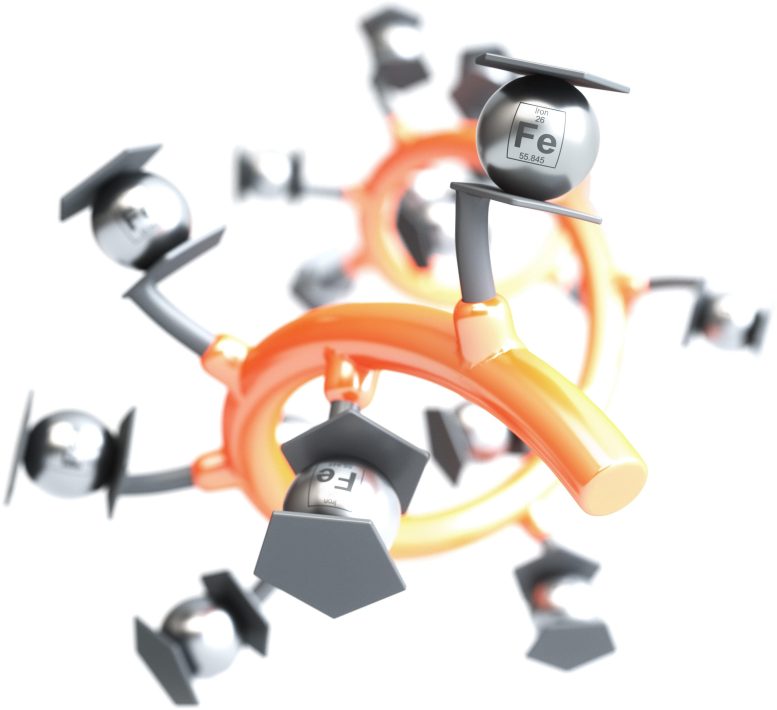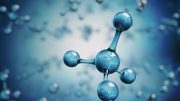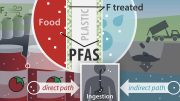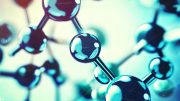
Graphical representation of a metal-containing polymer with ferrocene units used for reversible uptake of perfluorinated compounds. Credit: Markus Gallei
PFAS are incredibly versatile chemicals. These fluorine-rich organic compounds are what make raindrops effortlessly glide off our outdoor jackets. They serve as the non-stick layer on food packaging paper and are crucial components in fire-extinguisher foams and the safety equipment used by firefighters. Since their introduction in the 1940s, the range and scope of products incorporating PFAS have expanded significantly.
However, this widespread use is where concerns arise. Due to their stable nature and lack of natural degradation pathways, these durable chemicals persistently accumulate in our environment, posing significant problems for both human health and our surroundings. Today, traces of PFAS can be found globally: from water, air, and soil to plants and animals. And inevitably, they find their way into humans as well.
Just how much of a health risk these chemicals pose is still not clear. Initial laboratory animal studies have shown that PFAS may impair reproductive health. What is clear is that these synthetic compounds do not belong in the natural environment and certainly not in living organisms. It, therefore, makes sense to find ways to try and reduce PFAS contamination levels in the environment.
But PFAS remediation is both complex and challenging, and the processes used can themselves have a detrimental impact on the environment and the climate. And before they can be removed, the PFAS have to be detected. Detection is not made any easier by the fact that only small quantities of PFAS are required for a large effect (e.g. the ultra-thin coatings in food packaging).
Conventionally, PFAS have been removed from water by filtration using special membranes or lower-cost activated carbon adsorbents. However, recovering the PFAS from these filter systems so that they can be permanently destroyed either requires the use of harsh chemical conditions or incineration.
At least that has been the case up to now. A team of researchers led by Markus Gallei, Professor of Polymer Chemistry at Saarland University, Professor Xiao Su from the University of Illinois Urbana-Champaign, and their doctoral students Frank Hartmann (Saarland) and Paola Baldaguez (Illinois) have developed a new electrochemical method that can remove PFAS chemicals from water and then efficiently release them again for destruction. This new PFAS remediation platform allows these fluorinated contaminants to be collected, identified and then destroyed without needing to incinerate the filter.
In the method developed by the research team, the central role is played by metal-containing polymers known as metallocenes. Metallocenes first came on the scene in 1951 with the discovery of the iron-containing molecule ferrocene. Since then, many other metallocenes have been reported. Frank Hartmann, Markus Gallei, and their international team have found that electrodes functionalized with ferrocene or – even more effectively – with a cobaltocene synthesized by Frank Hartmann, are able to remove even minute quantities of PFAS molecules from water.
But the real key lies in the fact that if a voltage is applied to the ferrocene or cobaltocene metallopolymers, they can ‘switch’ their electrical state and release the PFAS molecules previously captured. ‘And cobalt is significantly better at doing this than iron,’ observed Frank Hartmann. ‘We’ve found a means by which PFAS can be efficiently removed from water and then released again, effectively regenerating the electrode for further use.
Unlike the activated carbon filter, which I have to destroy once it has become saturated with PFAS molecules, I can switch the metallocenes a thousand times, should I want to,’ said Markus Gallei, summarizing the significance of the research work.
Having laid the foundations, Frank Hartmann, Markus Gallei, and their colleagues at the University of Illinois are now looking to upscale development to facilitate the removal of these highly persistent contaminants from our rivers and oceans.
Reference: “Investigating the Electrochemically Driven Capture and Release of Long-Chain PFAS by Redox Metallopolymer Sorbents” by Paola Baldaguez Medina, Valentina Ardila Contreras, Frank Hartmann, Deborah Schmitt, Angelique Klimek, Johannes Elbert, Markus Gallei and Xiao Su, 28 April 2023, ACS Applied Materials & Interfaces.
DOI: 10.1021/acsami.3c01670









Ok, but what’s the uptake rate, how easy to foul etc. Do you out there know how many ideas are killed by such simple weaknesses and failures?
Unfortunately the writer only did 1 minute of research on PFAS and therefore neither knows current regulations or how harmful they are.
that you would paint the dangers of these chemicals as unknown is absurd and a disservice to science and people. they are incredibly toxic and HIGHLY carcinogenic and even the most minuscule amounts.
I’m beginning to think this article was written by a shill for the very corporations who are trying to reach an early settlement and be absolved of liability as part of the agreement as well.
I don’t think you should be allowed to literally pollute the entire world’s water supply with deadly chemicals and then get a soft shoe article like this.
this article should be pulled.
They should have sent the waste water next door to a precast concrete mix plant instead of making sure you drink it, or after brushing it on your teeth the coating dissolves and you swallow it all day until you all get cncer. But if you hate Americans you want them all sick in hospitals
Lame.